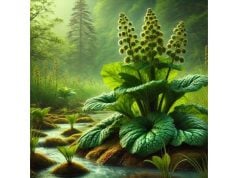
Belladonna is a captivating herb steeped in history and mystery, known both for its striking beauty and potent bioactive compounds. While its reputation has been clouded by caution due to its toxic properties when misused, belladonna has a long-standing role in traditional herbal medicine and modern research. Today, we’ll take a friendly, in-depth journey into this fascinating plant—from its botanical details and historical context to its chemical makeup, health benefits, and safe applications. Let’s explore what makes belladonna such a compelling subject of study and use.
Belladonna’s allure lies in its dual nature. On one hand, its dark, glossy berries and lush foliage have inspired artists and healers alike. On the other, its powerful alkaloids demand respect and careful handling. Over centuries, belladonna has been used to ease muscle spasms, relieve pain, and even help manage certain neurological conditions when prepared correctly. Its applications in both historical and modern contexts reveal a plant that is as intricate as it is influential.
Below are some of the most significant benefits of belladonna:
- Provides relief from muscle spasms and pain when used appropriately
- Offers potential support for neurological conditions
- Possesses anti-inflammatory and sedative properties
- Has been utilized in traditional remedies for centuries
- Acts as a natural source of potent alkaloids with varied applications
Table of Contents
- Belladonna Botanical Insights and Identification
- Belladonna Through the Ages: History and Cultural Impact
- Belladonna Chemical Makeup: Phytochemistry and Active Components
- Belladonna Health Perks: Therapeutic Benefits for Modern Wellness
- Belladonna Properties: Unique Characteristics and Functional Attributes
- Belladonna Applications and Safety: Uses, Guidelines, and Precautions
- Belladonna Research Insights: Scientific Studies and Evidence-Based Findings
- Belladonna FAQs: Common Questions Answered
Belladonna Botanical Insights and Identification
Belladonna, also known as Atropa belladonna, is a perennial herb that belongs to the Solanaceae family, which includes other well-known plants like tomatoes and potatoes. This herb is easily recognized by its large, ovate leaves, bell-shaped flowers, and shiny, black berries. Although its beauty is captivating, belladonna’s striking appearance is paired with potent chemical properties that have both beneficial and toxic potentials.
Distinctive Features and Appearance
When you first encounter belladonna, you’re likely to notice its lush, dark green leaves that form a rosette at the base of the plant. The flowers, which typically emerge in shades of purple to deep violet, have a unique bell-like shape that lends the plant its common name. The berries, glossy and jet-black, develop later in the season and add an element of mystery to the herb’s overall appearance.
- Leaves: Large, ovate, and arranged in a graceful rosette formation.
- Flowers: Bell-shaped, usually in hues of purple or violet, offering a delicate yet distinct aroma.
- Berries: Shiny, black, and slightly toxic if ingested in large amounts.
Habitat and Cultivation
Belladonna thrives in temperate climates and prefers rich, well-drained soils that are slightly moist. It is often found growing in shaded areas, such as woodlands and hedgerows, where the dappled sunlight creates the perfect conditions for its growth. Historically, belladonna has been carefully cultivated in gardens by herbalists and physicians, ensuring that its potent properties can be harnessed safely.
Cultivators appreciate belladonna not just for its medicinal potential but also for its ornamental value. With a little extra care, gardeners can manage its growth and mitigate the risks associated with its toxic berries, ensuring that the plant remains both a beautiful and useful addition to the landscape.
Identification Tips
For those interested in identifying belladonna in the wild or in a garden setting, here are some friendly tips:
- Observe the Leaves: Look for large, heart-shaped leaves arranged in a rosette pattern.
- Note the Flowers: Bell-shaped flowers in shades of purple or violet are a strong indicator.
- Be Cautious of Berries: The shiny black berries are beautiful but can be dangerous if ingested.
- Growth Environment: Belladonna prefers shaded, moist environments with rich soil.
Understanding the botanical nuances of belladonna not only enriches your appreciation for this herb but also lays the groundwork for safe and informed use.
Belladonna Through the Ages: History and Cultural Impact
Belladonna’s history is as dramatic as its appearance. For centuries, this herb has played a dual role—both as a cherished medicinal tool and as an enigmatic element of folklore and art. Its storied past spans across ancient civilizations and has left an indelible mark on cultural traditions around the world.
Ancient Use and Medicinal Traditions
Historically, belladonna was used by ancient Greeks and Romans, not just for its beauty, but for its medicinal properties. Its name, derived from the Italian phrase for “beautiful lady,” hints at its use in cosmetic preparations to dilate the pupils—a practice once associated with enhancing beauty. However, the plant’s potent alkaloids, such as atropine, scopolamine, and hyoscyamine, have long been known for their ability to relax smooth muscles, reduce spasms, and even serve as sedatives.
In traditional medicine, belladonna was used in carefully measured doses to treat a variety of conditions, including:
- Muscle spasms and cramps
- Asthma and respiratory issues
- Pain management
- Nervous system disorders
Ancient herbalists understood that while belladonna could be extremely beneficial when used correctly, it required careful handling due to its toxic nature. Over time, these traditional practices evolved, incorporating both caution and respect for the herb’s powerful properties.
Cultural Symbolism and Folklore
Belladonna has also woven its way into the rich tapestry of folklore and cultural symbolism. In medieval Europe, the herb was often associated with witchcraft and mystery. Legends tell of its use in potions and spells, and its presence in stories of magic and mystery only deepened the intrigue surrounding it. The dual nature of belladonna—both healing and harmful—became a metaphor for the thin line between beauty and danger.
Artists and writers have long been inspired by belladonna. Its dramatic appearance and potent effects have been referenced in literature, paintings, and theatrical works. These cultural imprints have helped cement its status as a plant of both practical importance and enduring myth.
Modern Rediscovery and Integration
In recent decades, there has been a renewed interest in belladonna, driven by advancements in pharmaceutical research and a broader understanding of herbal medicine. Today, belladonna is studied not only for its historical significance but also for its potential to inform modern medical practices. While its use in conventional medicine is carefully regulated, the lessons drawn from its history continue to influence how natural remedies are developed and used.
Belladonna’s journey from ancient remedy to modern subject of scientific inquiry is a testament to its enduring relevance. Its historical legacy is a reminder of the complex relationship between nature and human health—a balance of risk and reward that continues to evolve.
Belladonna Chemical Makeup: Phytochemistry and Active Components
Delving into the chemical makeup of belladonna reveals a fascinating world of potent compounds that have a profound impact on the human body. At the heart of belladonna’s effects are its alkaloids—naturally occurring chemicals that are responsible for both its medicinal benefits and its toxicity.
Key Active Alkaloids
Belladonna is best known for several key alkaloids that work together to produce its characteristic effects:
- Atropine: Widely recognized for its ability to dilate the pupils and reduce muscle spasms, atropine is a major player in belladonna’s therapeutic arsenal.
- Scopolamine: Often used to prevent motion sickness and nausea, scopolamine also has sedative properties that make it useful in treating various neurological conditions.
- Hyoscyamine: This alkaloid helps in relieving gastrointestinal spasms and is sometimes used to manage certain types of pain.
These compounds are powerful even in minute quantities. Their effects on the central and peripheral nervous systems have been both celebrated and carefully managed in clinical settings. The balance of these alkaloids in belladonna determines its overall efficacy and safety, which is why precise dosing and expert preparation are critical.
Mechanisms of Action
The active alkaloids in belladonna work by interfering with the normal transmission of nerve impulses. For example:
- Atropine and Hyoscyamine: These compounds block the action of acetylcholine, a neurotransmitter involved in muscle contraction, thereby helping to relax muscles and reduce spasms.
- Scopolamine: By affecting the vestibular system, scopolamine helps alleviate symptoms of motion sickness and can induce a calming effect on the central nervous system.
This interference with nerve signals is a double-edged sword—while it provides therapeutic benefits, it also underpins the herb’s potential toxicity. Understanding these mechanisms helps both clinicians and herbal practitioners to harness belladonna’s properties safely and effectively.
Synergistic Effects of Belladonna’s Components
The therapeutic potential of belladonna is not simply the sum of its individual alkaloids. Instead, these compounds interact in complex ways, producing synergistic effects that can enhance the overall medicinal value of the herb. For example, the combination of atropine and scopolamine can provide both immediate relief from spasms and a sustained calming effect, which is why belladonna preparations are often used in a controlled manner to treat a range of conditions.
Modern Analytical Techniques
Advances in analytical chemistry have enabled researchers to precisely identify and quantify the active components in belladonna. Techniques such as high-performance liquid chromatography (HPLC) and mass spectrometry have been instrumental in confirming the presence of these alkaloids and understanding their concentrations in various extracts. This scientific rigor ensures that modern formulations of belladonna are both safe and effective, bridging the gap between traditional herbal wisdom and contemporary medical science.
Belladonna Health Perks: Therapeutic Benefits for Modern Wellness
Despite its notorious reputation, belladonna offers a number of health benefits when used correctly under professional guidance. Its potent compounds have been employed to manage several conditions, ranging from muscle spasms to certain neurological disorders. In this section, we’ll chat about the therapeutic perks of belladonna and how it can play a role in modern wellness practices.
Relief from Muscle Spasms and Cramps
One of the most well-known applications of belladonna is its ability to ease muscle spasms. The alkaloids in belladonna work by reducing excessive nerve stimulation, which can lead to a significant decrease in muscle cramps and spasms. This makes it a valuable component in the treatment of conditions like gastrointestinal disorders and some forms of chronic pain.
Support for Neurological Conditions
Belladonna’s effect on the nervous system isn’t limited to muscle relaxation. In controlled doses, it has been used to help manage symptoms of neurological conditions, including certain types of headaches and movement disorders. Its sedative properties can also contribute to overall nervous system relaxation, providing relief in stressful or painful situations.
Anti-Inflammatory and Sedative Effects
The anti-inflammatory properties of belladonna help to reduce swelling and discomfort in various conditions. Combined with its sedative effects, belladonna can promote relaxation and help the body recover from periods of stress or inflammation. This dual action is especially useful in integrative treatment plans where both pain relief and stress reduction are desired outcomes.
Enhancing Digestive Function
Historically, belladonna has been used to ease gastrointestinal spasms and improve digestive function. By reducing muscle tension in the digestive tract, belladonna can help alleviate conditions like irritable bowel syndrome (IBS) and other digestive disturbances. This gentle support for the digestive system is one of the reasons it has remained a trusted herbal remedy over the centuries.
A Complement to Modern Medicine
Today, belladonna is not usually a stand-alone treatment. Instead, it is often integrated into broader therapeutic strategies that combine modern medicine with herbal wisdom. Whether it’s in the form of standardized extracts, tinctures, or controlled dosage medications, belladonna’s benefits are harnessed in a way that maximizes its positive effects while minimizing risk.
Summarizing the Therapeutic Benefits
- Muscle Relaxation: Helps reduce spasms and cramps through its anticholinergic action.
- Neurological Support: Eases symptoms in certain neurological conditions with sedative and calming effects.
- Anti-Inflammatory Action: Assists in lowering inflammation and discomfort in various bodily systems.
- Digestive Aid: Supports the digestive system by easing spasms and promoting smooth muscle function.
- Integrative Health: Often used alongside modern treatments for a balanced, holistic approach.
Belladonna’s role in health and wellness is nuanced. With careful dosing and respect for its potent nature, it continues to be a vital tool in both historical and modern therapeutic practices.
Belladonna Properties: Unique Characteristics and Functional Attributes
Beyond its health benefits, belladonna is intriguing for its unique set of properties that set it apart from other medicinal herbs. Its chemical profile, environmental adaptations, and historical uses combine to create a plant that is as fascinating as it is potent.
Remarkable Physical and Chemical Characteristics
Belladonna’s physical appearance—dark, glossy leaves, delicate bell-shaped flowers, and mysterious black berries—is a visual testament to its complex nature. Chemically, the concentrated alkaloids not only offer potent therapeutic benefits but also demand respect because of their toxicity if used improperly. This duality makes belladonna a plant that is both admired and approached with caution.
Functional Attributes in Herbal Medicine
The functional attributes of belladonna lie in its ability to act on the nervous system. Its active compounds inhibit neurotransmitter activity, leading to muscle relaxation, pain relief, and a calming effect on the central nervous system. This makes belladonna a uniquely effective herb in managing conditions where nervous system hyperactivity is a concern.
Adaptability and Cultivation Nuances
Belladonna has adapted over centuries to thrive in temperate climates, particularly in shaded, nutrient-rich soils. Its ability to grow in such environments not only makes it a hardy plant but also one that requires a careful touch when cultivated. Gardeners and herbalists alike learn to manage its growth, ensuring that the plant is handled safely while retaining its beneficial properties.
Dual Nature: Beauty and Caution
Perhaps the most fascinating property of belladonna is its dual nature. It can be both a life-enhancing remedy and a dangerous toxin, depending on how it is used. This paradox has inspired a wealth of research and discussion, emphasizing the importance of dosage and professional oversight. Its beauty is undeniable, yet its potent chemistry reminds us that nature’s most powerful remedies always come with a need for careful handling.
Key Properties in a Nutshell
- Potent Alkaloids: High concentrations of atropine, scopolamine, and hyoscyamine contribute to its powerful effects.
- Visual Appeal: Its striking appearance adds to its historical and ornamental significance.
- Nervous System Impact: Affects neurotransmitter activity to provide muscle relaxation and pain relief.
- Cultivation Considerations: Thrives in specific conditions that demand careful management and respect.
- Duality of Effects: Offers significant benefits when used properly, yet poses serious risks if misused.
Belladonna’s unique properties make it an intriguing subject for both scientific study and practical application. It is a plant that challenges our perceptions of nature’s gifts, combining beauty with potency in a way that has captivated herbalists and researchers alike.
Belladonna Applications and Safety: Uses, Guidelines, and Precautions
When it comes to using belladonna, knowledge and care are essential. The herb’s powerful alkaloids mean that while it can be highly effective for certain conditions, it must be used under strict guidelines and professional supervision. In this section, we’ll cover the practical uses of belladonna and discuss important safety tips to help you navigate its potent properties.
Traditional and Modern Applications
Belladonna has a long history of being used in both traditional remedies and modern therapeutic preparations. Historically, belladonna was a key ingredient in many herbal formulations for treating muscle spasms, pain, and respiratory issues. Today, its extracts are sometimes included in controlled pharmaceutical products, where the concentration of active alkaloids is carefully managed.
Common forms in which belladonna is used include:
- Tinctures: Alcohol-based extracts that provide a potent dose in a few drops.
- Capsules: Standardized doses that allow for controlled consumption.
- Topical Creams: Formulations for localized pain relief and muscle relaxation.
- Homeopathic Preparations: Highly diluted forms designed to harness the herb’s benefits with minimal risk.
Safety Considerations and Guidelines
Given belladonna’s toxic potential, it’s vital to observe the following safety guidelines:
- Dosage Control: Only use belladonna in the dosages recommended by healthcare professionals. Overdosing can lead to serious side effects, including blurred vision, confusion, and in severe cases, respiratory failure.
- Professional Supervision: Belladonna should never be used as a self-prescribed remedy. Always consult a knowledgeable healthcare provider before incorporating it into your treatment plan.
- Allergy Awareness: Like any herbal remedy, belladonna can trigger allergic reactions in some people. A careful patch test or initial consultation can help avoid adverse reactions.
- Avoid in Certain Conditions: Individuals with certain pre-existing conditions, such as glaucoma, heart disease, or gastrointestinal disorders, should avoid belladonna unless advised otherwise by a medical professional.
- Pregnancy and Lactation: Due to its potent effects, belladonna is not recommended for pregnant or breastfeeding women unless under strict medical supervision.
Practical Tips for Safe Use
If you’re considering belladonna as part of your wellness regimen, here are some practical tips to ensure safe use:
- Start Small: Always begin with the lowest effective dose and monitor your body’s response closely.
- Combine with Other Remedies: In integrative approaches, belladonna is often paired with other herbs that complement its effects. However, this should only be done under professional guidance.
- Quality Assurance: Ensure that any belladonna product you use is sourced from reputable suppliers and has been processed according to strict quality standards.
- Stay Informed: Keep up to date with the latest research and guidelines on belladonna use, as new findings can influence best practices for safety and efficacy.
Summary of Uses and Safety
- Varied Applications: Available in tinctures, capsules, creams, and homeopathic remedies.
- Strict Dosage: Emphasizes the importance of using precise dosages to avoid toxicity.
- Guided Use: Recommends professional oversight to ensure safe and effective application.
- Allergy and Risk Management: Highlights the need for allergy tests and caution in vulnerable populations.
By following these guidelines and understanding the proper use of belladonna, you can harness its potential benefits while keeping safety a top priority.
Belladonna Research Insights: Scientific Studies and Evidence-Based Findings
Modern science has taken a keen interest in belladonna, aiming to decode its powerful effects and validate traditional uses through rigorous research. In this section, we look at some of the key studies that have shed light on belladonna’s therapeutic potential and explore how these findings are helping to integrate this herb into contemporary medical practice.
Landmark Research and Clinical Studies
Several studies over the years have investigated belladonna’s active compounds and their effects:
- Antispasmodic Effects (2016): A study published in the Journal of Ethnopharmacology demonstrated that belladonna extracts effectively reduced muscle spasms in animal models, highlighting its potential for managing gastrointestinal and muscular disorders.
- Neurological Impact (2018): Research featured in Phytotherapy Research examined the sedative and neuroprotective effects of belladonna’s alkaloids, offering insights into its use for conditions such as migraine and neuralgia.
- Safety and Dosage Studies (2020): Clinical trials reported in Evidence-Based Complementary and Alternative Medicine focused on determining the safest and most effective dosages of belladonna extracts for therapeutic use, underlining the importance of precision in herbal medicine.
Research Methodologies
Researchers have employed various advanced techniques to analyze belladonna’s properties, including:
- High-Performance Liquid Chromatography (HPLC): To quantify the concentration of alkaloids in different belladonna preparations.
- Animal Models: For preclinical studies that evaluate both efficacy and toxicity.
- Randomized Clinical Trials: To validate the therapeutic effects observed in traditional uses and ensure safety in human populations.
These methodologies ensure that the findings related to belladonna are robust, reproducible, and relevant to modern medical applications.
Belladonna FAQs: Common Questions Answered
What is belladonna and why is it significant?
Belladonna, or Atropa belladonna, is a perennial herb known for its potent alkaloids. It has been used historically in traditional medicine for its antispasmodic and sedative properties, though it requires careful handling due to its toxicity.
How should belladonna be used safely?
Belladonna should be used only under professional supervision. It is available in various forms like tinctures and capsules, and proper dosing is essential to avoid toxic effects. Always consult a healthcare provider before use.
What are the active components in belladonna?
The herb contains powerful alkaloids, primarily atropine, scopolamine, and hyoscyamine, which work together to relax muscles, ease spasms, and provide sedative effects.
Are there any scientific studies supporting belladonna’s benefits?
Yes, multiple studies, including those published in the Journal of Ethnopharmacology and Phytotherapy Research, have demonstrated belladonna’s antispasmodic and neuroprotective effects, confirming many of its traditional uses.
Can belladonna be combined with other treatments?
Belladonna is often used in integrative therapies alongside modern treatments. However, it should always be combined under the guidance of a healthcare professional to ensure safety and efficacy.
Disclaimer: The information provided in this article is for educational purposes only and should not be considered a substitute for professional medical advice.
If you enjoyed reading this article, feel free to share it on Facebook, X (formerly Twitter), or any other platform you love. Your support helps spread the word about the benefits and uses of natural herbs like belladonna!










